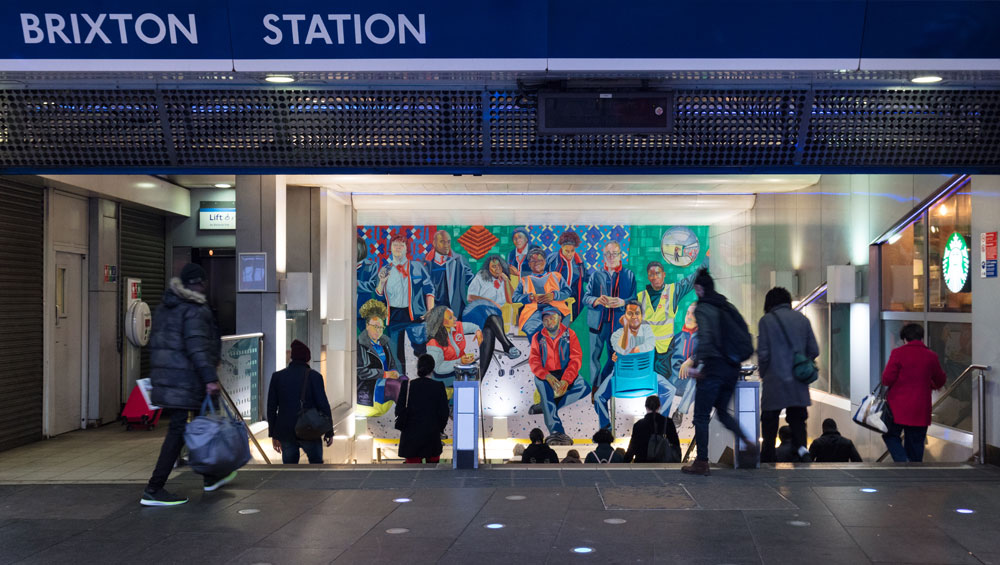
Aliza Nisenbaum, London Underground: Brixton Station and Victoria Line Staff, 2019. Commissioned by Art on the Underground. Photo: Angus Mill.
by ALLIE BISWAS
Aliza Nisenbaum (b1977, Mexico City) studied psychology before taking a BFA and MFA at the School of the Art Institute of Chicago. Although her early work as a painter consisted of still-lifes and large abstractions, in 2012 she found herself returning to the subject of people – and their personal experiences. As an art and English teacher at Immigrant Movement International, a community centre set up New York by Cuban performance artist Tania Bruguera, Nisenbaum began to paint portraits of the Mexican and Central American immigrants who visited the space.
It was a formative moment for Nisenbaum, who has spent the past few years making paintings that focus on the close exchanges she has with her subjects – most often those who are identified as undocumented immigrants, and figures from marginalised communities. Her observational paintings act as revised representations of people who may be depicted insensitively in mainstream accounts, or be totally ignored.
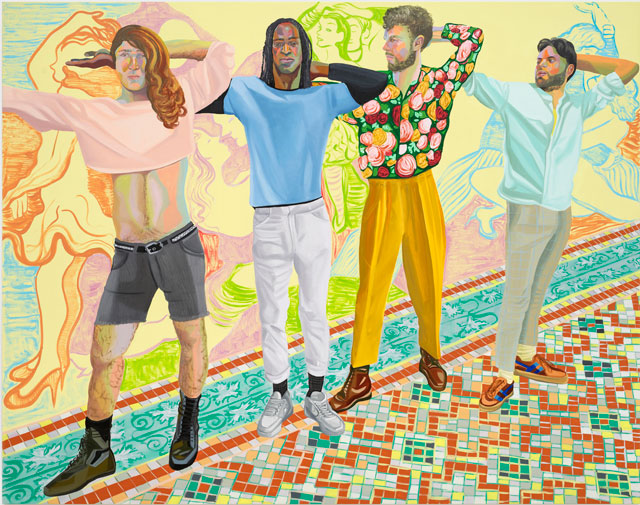
Aliza Nisenbaum, Camillo's Choreography, 2018. Oil on linen, 193 x 241 cm (76 x 95 in). Courtesy of the artist and Mary Mary, Glasgow.
For her first public art project in the UK, commissioned by Art on the Underground, Nisenbaum has created a mural for Brixton tube station in south London. The artist spent three months living and working in Brixton, which is known for the striking murals created in the aftermath of the riots there in the early 1980s. Nisenbaum was as inspired by these community artworks, which can still be seen on the exteriors of various buildings, as she was by the Mexican mural movement, which has been a longstanding influence. For her project, which will remain inside the station’s entrance until September, Nisenbaum selected 15 people working for Transport for London, on the Victoria line, and, over several hours, painted them individually in her studio. The result is a large-scale group portrait that pertinently examines the idea of community in this pre-Brexit moment.
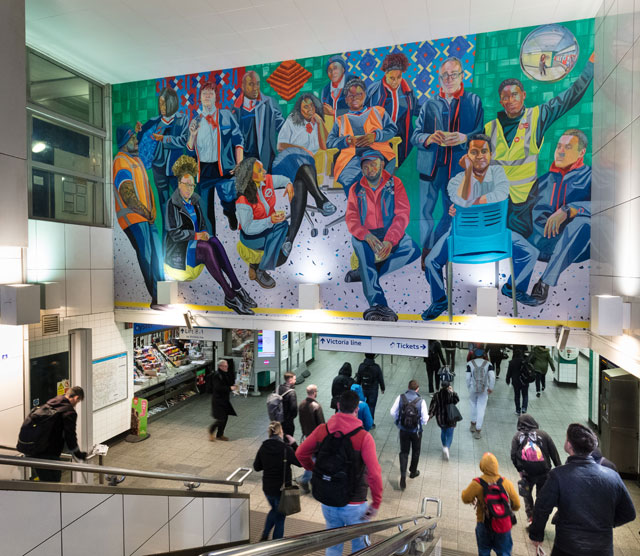
Aliza Nisenbaum, London Underground: Brixton Station and Victoria Line Staff, 2019. Commissioned by Art on the Underground. Photo: Angus Mill.
Allie Biswas: I understand that you always had a desire to live in New York. What was interesting to you about the city, and how did the city impact on your art?
Aliza Nisenbaum: At this point, I have lived half my life in the United States and half in Mexico City. I moved to New York City from Chicago where I had been living for 10 years, studying at the Art Institute of Chicago. New York was so much more like Mexico City – bigger, more chaotic and more international. My family used to travel to New York for my dad’s business and we would go to the museums together. I still have the Matisse catalogue we bought during one of those trips.
AB: When did you first encounter Tania Bruguera? This seems like a pivotal meeting, given your involvement with Immigrant Movement International. Can you tell me about the art project that you developed through IMI, and was this a critical moment in terms of your focus on portraiture, or had you been thinking about the figure, and community, before this; for instance, when you were studying at the Chicago Institute?
AN: I first met Tania in Chicago in about 2004. I saw her lead a critique for MFA graduate students when I taught a class on drawing at the University of Chicago. She didn’t know me then, but many years later, in New York, she gave a lecture at the Cooper Union introducing her project, Immigrant Movement International. I was so impressed and approached her to see if I could volunteer at IMI. She asked if I could teach an English class in Corona, Queens, as that was what was desperately needed at that time and in that area. As I’m not a language teacher, but bilingual, I proposed a class where I could provide language skills, while making the subject matter art. The class was called “English through feminist art history”. We would look at quotes by female artists who have inspired me historically, then translate them from English into Spanish. Afterwards, things started to move quite organically from that class. I was intrigued by the stories the women would tell me about their courageous journeys across the border, and their current situation. At one point, I became a translator for one of them during a conversation with a congresswoman in Queens advocating for women’s rights and domestic violence.
Once my class ended, I wanted to remain involved with IMI. I asked Tania if I could paint life portraits of some of the people in my class. Later, I would paint their husbands and sometimes their entire extended families. I would first meet with my sitter, go out to lunch with them and set up my portable easel to paint. IMI was the first place where I showed this work. Later, my sitters would join me at my first solo exhibition at White Columns in New York, and, years after, at the 2017 Whitney Biennial. I’m still in touch with some members from this group.
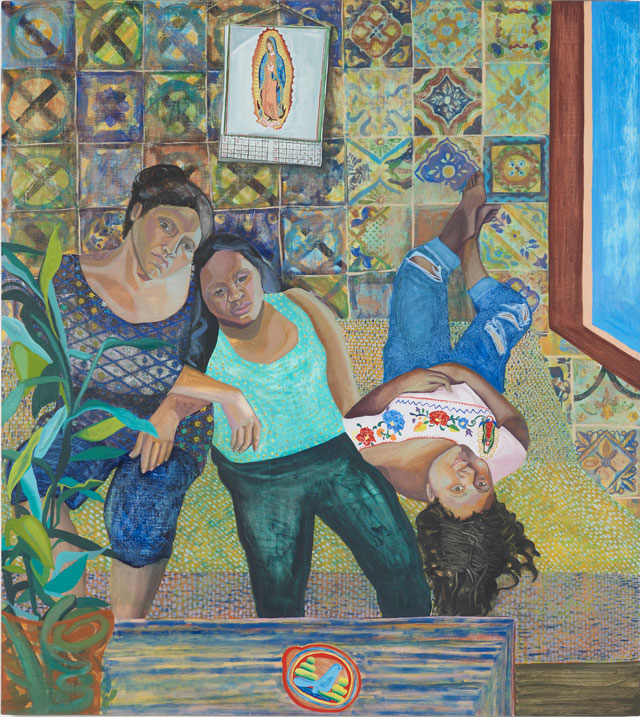
Aliza Nisenbaum, Las Talaveritas, 2015. Oil on linen, 162.6 x 1448 cm (64 x 57 in). Courtesy of the artist and Mary Mary, Glasgow.
My interest in the ethics of portraiture and representation goes back quite far. When I was in Mexico City, before deciding to be an artist, I studied psychology for two years in college, doing field work in a mental institution and various public schools. I was torn between wanting to be a social worker interested in social justice issues or a painter working in the solitary space of my studio. It took about 15 years to be able to find a way to integrate these interests.
AB: The projects that you have realised in the past few years have maintained at their centre an element of social interaction, and social realism. Your paintings have also repeatedly reflected on immigrants. What in particular interests you about depicting people in the US who describe themselves as immigrants? And how much of your own story do you think merges into this interest? Is visibility at the heart of your project?
AN: At the heart of my project is sitting with people and going through the slow process of painting from life. Inevitably, a kind of ethics comes from that. It’s not really about visibility. Clearly, I’m interested in painting people who might not have entered the canon of art historical portraiture in the past. Portraits in oil have historically been the medium of representing kings and queens; the medium of power, in a way. My own history is one of immigration, for sure, but my identity – like that of my sitters – extends way beyond contemporary politics and the reduction to a definable “category” such as “immigrant”. My family did emigrate from Russia, fleeing the massacres of the Jewish people, and settled in Mexico, and, later, I made my way to the US. My mum is Scandinavian-American, so there’s quite a mix, but immigration is really not the core of my work.
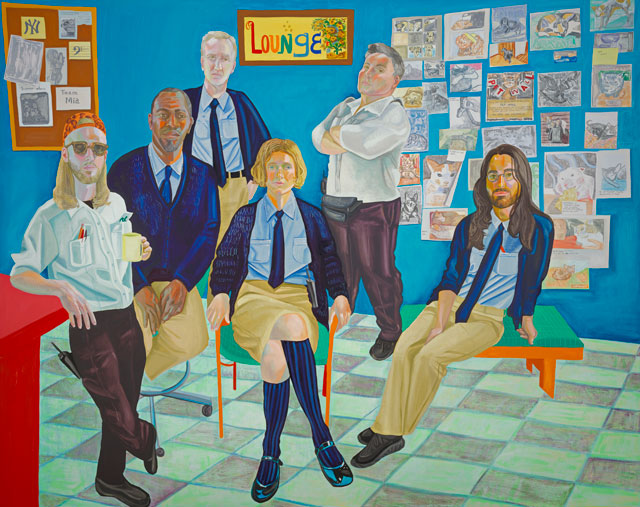
Aliza Nisenbaum, Morning Security Briefing at the Minneapolis Institute of Art, basement door open onto the Guard Lounge Pet Wall, 2017. Oil on linen, 190.5 x 241.3 cm. Courtesy of the artist and Mary Mary, Glasgow. Photo: Dan Dennehy, Minneapolis Institute of Art.
I’m much more interested in what it means to sit silently, in a relaxed setting, chatting with someone while you go through a very slow process of looking and paying attention, then translating that to paint. Only when you paint from life can you really see all the nuance of colour temperatures and hues that make a skin so complex. The process entails sitting with someone who I might not know very well, and who might be very different from me and, at times, spending three to six hours getting to know them. I try to do their image and character justice, and perhaps get a likeness. Most of the time these sittings are fun, but other times intimate, political or difficult conversations happen during the sitting. It’s a vulnerable thing for both me and the sitter. Yet, we often find common ground through the long process.
AB: In relation to your Art on the Underground commission, how did your perspectives on community develop when coming to London and engaging with Transport for London staff? And what was the process for selecting who you would paint?
AN: We sent out an open call for Transport for London staff working across the Victoria line, from train drivers and operational staff to those working in facilities and administration. I was so moved by the responses we received. Many of the applications expressed pride in working for TfL. They felt they represented the diversity of the community. Many of the people who work in Brixton station have seen the area develop and change, and seen the station becoming a landmark and extremely busy. Some of them took the train as children, and now mentor youth from the local neighbourhood. They wanted their portrait to stand for the change one can see across generations. Others came to this area as a result of immigration and the Windrush generation. I was pleased to hear that some of my sitters are artists or actors themselves in their free time. I consider it a huge honour to be able to bring these faces out to the public sphere.
Initially, I met all the sitters in groups of five over coffee and cookies in the studio. There, I started to observe some relationships between people who knew each other and might want to be depicted next to one another. I was interested in showing this community, but I also felt that, in the time we all worked together, my painting may have brought people who didn’t know each other into contact, thereby creating another set of relationships.
AB: How would you describe Brixton? What were your immediate thoughts? Were you already aware of the neighbourhood’s rich history, particularly in relation to its Afro-Caribbean community, before taking up your residence?
AN: Before I arrived, I researched the area and read up on Brixton. I loved living a few blocks away from the station and it was great to work in a backroom of the station itself. I was really immersed in the local neighbourhood, but also in the culture of the train operators and the “behind the scenes” life of the station.
Brixton has such a rich history, being one of the first places where migrants from the Windrush generation arrived. When London was being rebuilt in the 1940s and 50s, many West Indian immigrants settled in Brixton and have contributed to its unique energy ever since. During the 80s, London became an important centre for mural production. Murals from this particular period reflect the political climate, social context and communities who collaborated to make them. The Greater London Council commissioned many of the murals in Brixton as a way to unify the communities and respond to some of their concerns. If you walk around the neighbourhood and look at the murals, you can see what the pertinent issues were at that time – from trying to deal with racial tensions in the area and the threat of the cold war to residents wanting to brighten up their urban environments.
AB: How did the neighbourhood itself influence the mural that you completed for the station?
AN: The neighbourhood itself, of course, influenced the mural I made. The colours in the surrounding markets are bright and vibrant and I want my work to resonate with that. I included icons from the station, such as the Brixton bricks and the other elements that one encounters inside the station itself. Like the “Mind the gap” yellow line, the fabrics inside the Victoria Line trains and other elements of the underground.
AB: Art on the Underground’s 2019 programme is themed around what it means to be “on edge” – what was your perspective as a New Yorker, engaging with London and its people within this pre-Brexit period?
AN: I’ll just say that we are living through very similar political realties in the US and in Great Britain. It seems like the place where people find “community” is on social media, which can lead to all kinds of misunderstandings. I think there is something to be said for sitting with people and slowing things down, particularly now.
AB: Finally, what were your own experiences of London’s transport system?
AN: The London transport system is definitely more efficient than the New York subway! The trains are bright and colourful on the inside and they appear to be a lot cleaner. I did see plenty of cute wild foxes on the streets of Brixton when I walked home late at night after finishing painting in the studio. This was one of my favourite surprises, given that, coming from Mexico, I had never seen a wild fox before.
• Aliza Nisenbaum’s mural will be on display at Brixton underground station until 16 September 2019. Tours of the Brixton Murals will be held during May, June and July in conjunction with the London Mural Preservation Society. For more details, visit art.tfl.gov.uk.